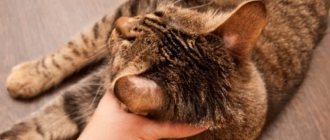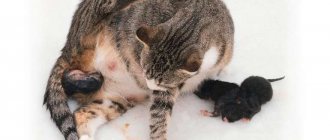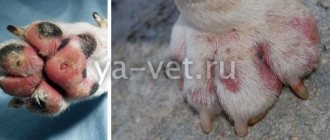Sterilizing a cat sometimes results in blood loss. Internal bleeding in cats is a dangerous condition that develops when the walls of blood vessels are damaged and gastrointestinal diseases occur. Minor blood loss is not dangerous for the animal. However, with significant blood loss, disruption of the functioning of the digestive tract and oxygen starvation of tissues occurs, which can lead to serious consequences for the body.
Diagnostics
The main ways to diagnose internal bleeding in cats include:
- taking anamnesis;
- visual inspection;
- radiography;
- laparocentesis;
- blood tests;
- general urine analysis;
- vaginal smear;
- Ultrasound of the abdominal cavity;
- CT;
- MRI.
Timely diagnosis is carried out to identify signs of internal bleeding in a cat and organize comprehensive treatment.
Intra-abdominal bleeding
Intra-abdominal bleeding or, as it is called in medical practice, hemoperitoneum is an outpouring of blood into the abdominal cavity or retroperitoneal space associated with damage to organs and blood vessels located in this area. Most often, hemoperitoneum is caused by damage to vessels located in the omentum, mesenteries, folds and ligaments of the peritoneum. As for organs, in most cases the pancreas, liver and spleen are affected. Intra-abdominal bleeding is a deadly condition. But if you know its main symptoms and take timely measures, complications can be avoided. Causes All causes of intra-abdominal bleeding can be divided into two main groups. The first includes causes of a traumatic nature: chest injuries (for example, fractures of the lower ribs can provoke damage to internal organs from bone fragments); blunt abdominal injuries caused by compression, falls, or strong blows; gunshot or knife penetrating wounds to the abdominal area; damage after certain operations (gastric or liver resection, nephrectomy, appendectomy, cholecystectomy) associated with complications, slipping of ligatures used for ligating blood vessels, or surgeon errors. Non-traumatic causes include mainly complications of diseases of internal organs: rupture of an aortic aneurysm; severe damage or rupture of the fallopian tube during ectopic pregnancy; ruptures of cysts of internal organs; ovarian apoplexy; liver hemangioma; long-term use of drugs that reduce blood clotting (fibrinolytics or anticoagulants); diseases accompanied by a significant decrease in blood clotting (these include hemorrhagic diathesis, obstructive jaundice, malaria). Symptoms Symptoms of intra-abdominal bleeding will depend on its intensity, the location and size of the damaged vessels or organs, and the nature of the damage. So, with minor bleeding, the manifestations will be blurred and unexpressed, and with severe and sudden bleeding, they will be obvious and acute. The following signs of hemoperitoneum are possible: general weakness, loss of strength, muscle atrophy; blanching of the mucous membranes of the skin; increased sweating; increased heart rate (sometimes up to 120 or even 140 beats per minute); dizziness; darkening of the eyes; fainting or shock; pain in the area of the damaged organ (such pains are called abdominal, they are pronounced, can radiate to the shoulders, chest, shoulder blades or back and force the patient to take a sitting position, which alleviates the condition); loss of consciousness; The abdominal cavity is soft, not compacted. For more information about symptoms and first aid, watch the following video: Diagnosis If hemoperitoneum is suspected, the patient must be urgently taken to the hospital for an accurate diagnosis and medical care. The specialist will examine the patient. By palpation, the doctor will determine the possible nature and location of the damage. But to clarify the diagnosis, diagnostic procedures will be required. The most complete picture is revealed by ultrasound, radiography, and diagnostic laparoscopy. Blood tests can also be informative, allowing you to determine the level of hemoglobin (with blood loss it will decrease), hematocrit and other indicators. Treatment If intra-abdominal bleeding is suspected, the patient should be immediately placed on a flat horizontal surface. Moving before doctors arrive is contraindicated. Cold may be applied to the abdominal cavity. Ingestion of liquids or food is strictly contraindicated. Measures should be taken immediately and intensive care should be started. It includes resuscitation, antihemorrhagic and antishock measures: Surgical intervention, infusion of blood substitute solutions, administration of analeptics (these drugs have a stimulating effect on the vasomotor and respiratory centers of the brain), reinfusion (collection of blood poured into the retroperitoneal space or abdominal cavity and its re-infusion ). Also, in most cases, surgical intervention is required, the purpose of which may be to restore the integrity or remove damaged organs, as well as ligation of blood vessels. Complications With significant blood loss there is a risk of death. But even if the bleeding has stopped, an infection can develop, which in most cases leads to peritonitis - inflammation of the membranes covering the internal organs and lining the abdominal cavity. Enlarged liver Find out what the symptoms and treatment of peritonitis are at the link above. What is the characteristic of another abdominal disease - ascites? Find out why it is dangerous here. Prevention To reduce the risk of developing intra-abdominal bleeding, you should undergo routine examinations on time and treat any diseases of the internal organs, as well as consult a doctor in case of injuries. It is extremely important to detect intra-abdominal bleeding in time and take the necessary measures.
Treatment
How to stop internal bleeding in a cat? In this case, various treatment methods are used, which depend on the severity of the animal’s condition. It is necessary to contact a veterinarian to draw up a treatment regimen, but independent attempts to help can cause the death of the animal.
The main methods of treatment for hemorrhage include:
- pain relief - to improve the pet’s condition;
- intravenous infusion - to stabilize blood pressure;
- blood transfusion - for anemia;
- compression bandages - slowing down blood loss;
- vitamin K - for poisoning and coagulopathies;
- emergency surgery.
Often internal bleeding after sterilization of a cat causes severe complications, including death. Therefore, when the first symptoms of the process appear, it is necessary to urgently contact professionals. To prevent hemorrhage, you should properly care for a sterilized animal.
How to treat blood in stool
Depending on the underlying cause for the appearance of such a symptom as blood in the cat’s stool, the doctor prescribes therapeutic methods. The appearance of diarrhea with blood in a pregnant cat requires special attention, since self-medication is not acceptable. As a result of the increased load on the body during pregnancy, the cat's body experiences a deficiency in its defenses.
The development of infection in a pregnant cat occurs many times faster than in a pet during normal times, and therefore requires immediate medical intervention.
If a cat is diarrhea with blood as a result of an infectious lesion, antimicrobial agents are prescribed to eliminate the inflammatory process in the intestines. In addition to antibiotics, non-steroidal anti-inflammatory drugs, antihistamines, hepatoprotectors and enzymes are prescribed.
Diagnosed tumor processes or polyposis of the large intestine require surgical intervention followed by removal of the tumors. In all cases of blood appearing in the feces of a cat, the animal is transferred to a special diet.
For chronic constipation in a cat, accompanied by the appearance of blood, laxatives are prescribed to thin the stool. In advanced cases, the animal is given an enema to cleanse the gastrointestinal tract.
Treatment of anal fissures is carried out by introducing special rectal suppositories with healing compounds.
Tests to Confirm Gastrointestinal Bleeding in Small Pets
If physical examination and history do not reveal obvious symptoms of gastrointestinal bleeding in dogs and cats, hematological and biochemical studies are performed, the results of which may suggest bleeding. Anemia of unknown etiology may lead to the assumption of bleeding from the gastrointestinal tract; it is described that microcytic hypochromic anemia (iron deficiency anemia) develops as a result of chronic blood loss in the gastrointestinal tract. Because iron deficiency anemia takes time to develop, a more typical consequence of recent bleeding is normocytic normochromic anemia. A high urea-creatinine ratio (greater than 20) has been described in gastric and intestinal bleeding, especially if the bleeding occurs from the upper gastrointestinal tract. This is due to bowel movements and intestinal absorption of proteins (may increase the level of digested and absorbed protein), including digested blood, into the circulatory system (blood). Massive intestinal bleeding, as described, has little effect on urea levels. However, once protein metabolism is activated as a result of illness (fever, infection, fasting or use of glucocorticosteroids), the urea-creatinine ratio may also increase, which must first be concluded to be the cause of gastrointestinal bleeding in dogs and cats.
In doubtful cases, a fecal occult blood test is performed. Most tests are based on the peroxidase activity of hemoglobin. Although the test is useful in detecting occult bleeding, it is possible to obtain a false positive result. This is influenced by the following factors: diets that include red meat or foods with high peroxidase activity, such as fruits, fish, vegetables. The result is also affected by bacteria with peroxidase activity present in the gastrointestinal tract. This must be kept in mind when receiving test results based on chemical characteristics.
It should be recommended to exclude meat from the animal’s diet for at least 72 hours. On the other hand, a negative occult blood test excludes significant GI bleeding. When significant gastric bleeding is suspected but not confirmed, a nasogastric tube is inserted and the gastric contents are aspirated. This will help confirm and determine the location of the bleeding. Although the procedure can cause discomfort and falsely described - negative results.
Symptoms
If two or more signs occur, the owner must immediately contact the clinic, especially if the pet has cardiac problems or has recently been under anesthesia (up to 2 weeks). Symptoms may be associated with other lung pathologies, but in any case, this means that the cat requires medical attention.
Signs of a condition such as pulmonary edema are:
- Shortness of breath, abdominal type of breathing (the cat breathes with its stomach).
- Rattles and gurgles when the cat breathes.
- Breathing with an open mouth “like dogs.” This type of breathing is not typical for cats, only within one to two minutes after physical activity.
- Cyanosis (the cat's mucous membranes are blue or purple).
- Severe lethargy and weakness due to hypoxia (lack of oxygen).
- Cough.
Diagnosis of pulmonary edema
Diagnosis of pulmonary edema in cats is based on medical history, clinical symptoms, auscultation (listening to lung sounds) and radiography. However, if the cat is in critical condition and there is a threat to life, primary treatment should be carried out without additional diagnostics until the condition has stabilized.
After relief of the acute condition (the treatment algorithm is similar, regardless of the cause), additional diagnostics should be carried out to determine the cause.
Preventing pulmonary edema in cats
If we are talking about animals with previously diagnosed cardiac pathology, regular examination of the animal by veterinary specialists, accurate determination of the functional degree of heart failure and timely treatment will help avoid the development of pathology.
Prevention of cardiogenic edema in young, clinically healthy animals involves conducting screening studies before surgery, this is especially important if the cat belongs to risk breeds.
(c) Veterinary center for the treatment and rehabilitation of animals “Zoostatus”. Varshavskoe highway, 125 building 1. tel. 8 (499) 372-27-37
Causes of bleeding in cats
There are many reasons why a cat may bleed from the mouth. It is almost impossible to make an accurate diagnosis based on clinical examination alone.
There are several underlying factors that can cause bleeding from a pet's mouth. The main ones are:
- damage to the integrity of the oral mucosa;
- damage to pulmonary structures;
- poisoning with toxic substances;
- damage to liver structures;
- bleeding in the stomach.
Damage to the oral mucosa occurs quite often in cats as a result of increased activity of the animal and as a result of fights with competitors. Small kittens can injure their oral cavity with foreign objects, since in the process of learning about the world they often try everything.
Bleeding from the mouth when the gums, palate or tongue are damaged, is accompanied by small discharges of a red or pinkish tint. For minor injuries, the blood stops flowing on its own after 5-10 minutes. In case of more serious damage to the oral mucosa, bleeding may take longer.
It is worth paying attention to the nature of the leakage - if the blood flows jerkily, then this indicates damage to a large capillary in the head area and can have serious consequences if assistance is not provided in a timely manner.
The appearance of bloody vomiting in a cat with foam may indicate damage to the pulmonary structures. With pulmonary hemorrhages, the amount of blood flowing out is small, and the clotting process is practically absent.
If you find your pet vomiting pink foam, you need to show the animal to a veterinarian as soon as possible. Any delay can cost your pet's life.
Poisoning with toxic substances. Cats are often poisoned with poisons intended to kill rodents. All poisons aimed at controlling rodents have the property of inhibiting enzymes responsible for blood clotting factors. With an acute shortage of blood clotting factors, the cat experiences internal bleeding. And one of the symptoms of acute zoocoumarin poisoning is when a cat vomits blood. A pet can be poisoned not only by rat poison, but also by household chemicals, as evidenced by vomiting brown blood, which is associated with damage to the mucous membranes lining the stomach.
Liver diseases and problems associated with blood clotting disorders lead to damage to all internal organs and systems. If an animal begins to vomit and there is blood in the vomit, this may indicate the onset of destructive processes in the liver or hematopoietic system.
The appearance of vomiting with blood is also observed during exacerbation of chronic diseases of non-contagious etiology. It is noted that such vomit does not have a foamy structure.
Damage to the gastric mucosa leads to bleeding from the cat's mouth. More often, a violation of the integrity of the walls of the stomach is accompanied by vomiting and eruption of gastric contents. The pet refuses food and sometimes water. The released blood acquires a characteristic brown color and a repulsive odor.
The main cause of damage to the walls of the stomach is foreign objects and malignant neoplasms in the digestive system, as well as ulcers.
Vomiting of blood during tumor processes is observed, as a rule, already in the last stages, when the diagnosis is already known earlier. Gastric ulcers are not uncommon for cats, but timely diagnosis and correct treatment tactics can prolong the animal’s life, preserving its functionality and eliminating discomfort.











